The first shot ripped across the baseball diamond at 7:06 am.
Powww!
“What the f— was that?” said Representative Rodney Davis.
It was the last practice before the Congressional Baseball Game, a clear June morning, and the Republican team was wrapping things up. Standing near home plate, Texas congressman Roger Williams, the head coach, had been smacking the final few grounders of this Wednesday-morning workout. Davis, from Illinois, was digging his cleats into the batter’s box and lunging at a couple of closing pitches. In the outfield, aides tracked down fly balls. Neighbors of the park in Alexandria, out walking their dogs, took in the quaint panorama—two dozen grown men cracking jokes and playing ball.
Then, the thundering blast.
For a moment, everyone froze. A political consultant who was playing catcher stood up, took off his mask, and looked toward third base, where the sound had originated. From home plate, Davis studied the tree line in left field, expecting to see a cloud of dust from whatever must have exploded.
At third base, Trent Kelly, a first-term member from Mississippi, looked to his right and saw a short, stout man on the opposite side of the chainlink fence, only 20 or so feet away. The two locked eyes. The man was pointing the long barrel of a rifle directly at Kelly—and he was smirking. “He had the most nasty, sinister, just evil look on his face,” Kelly says. “Kind of like ‘I just shot and killed you, and you don’t even know it yet.’ ”
Kelly hollered to his teammates: “He’s got a gun!”
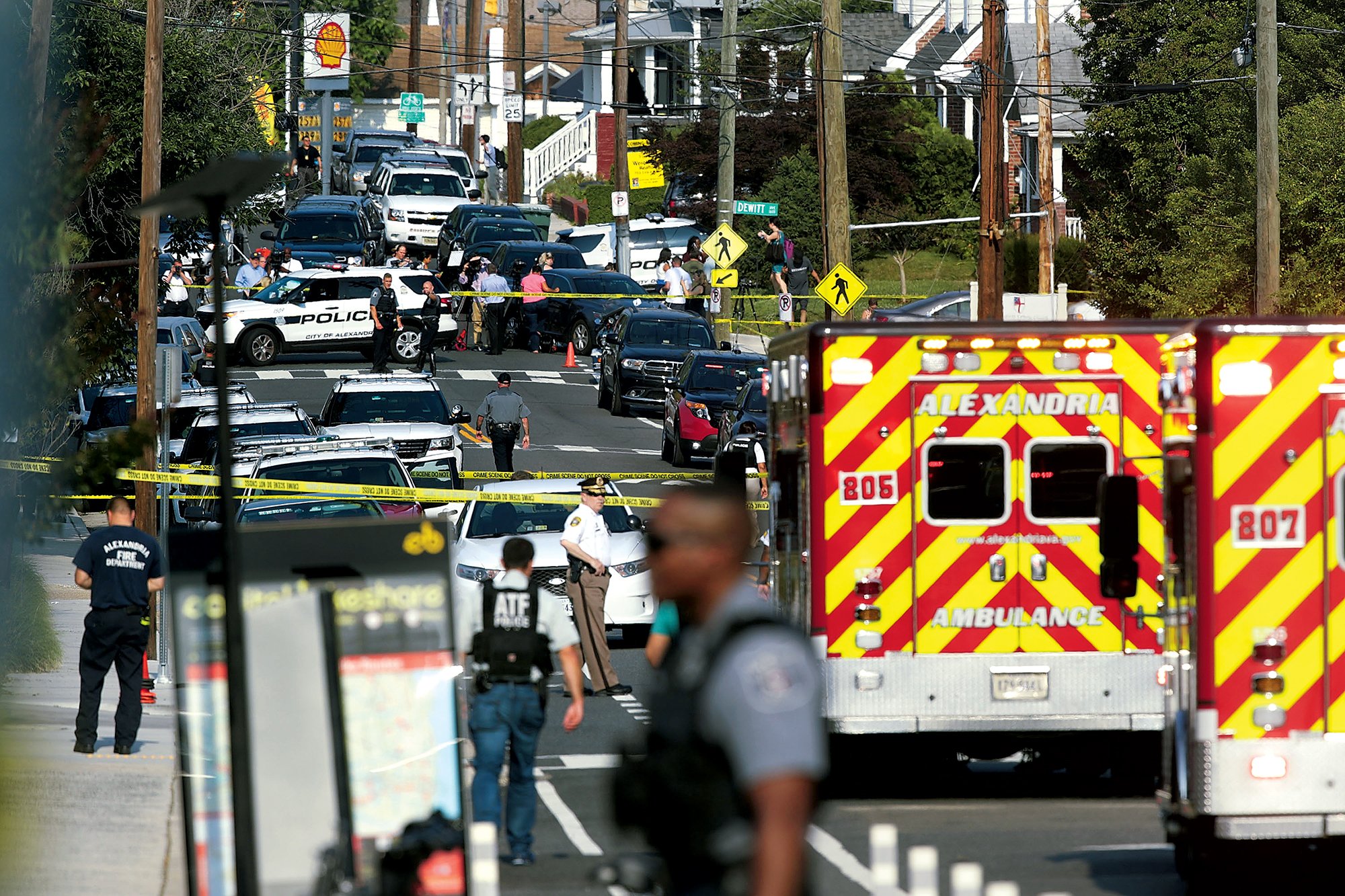
As the stadium erupted in chaos, Kelly watched time elapse frame by frame. He instantly concluded that the gunman had taken a point-blank shot at him but missed. Kelly believed that he was still the shooter’s closest target and that the second bullet was imminent. He had to get away.
Instead of running in a straight line, he zigzagged to his left and then to his right, a tactic he’d learned in the Army. He was halfway to second base when he heard shot number two crack past his left shoulder. Convinced the gunman was still aiming for him, he darted to his right and raced toward first base. He cut behind the pitcher’s mound just as the third shot sizzled by his chest. The bullet missed him, Kelly says, but it continued whizzing in the direction of Steve Scalise, the congressional leader from Louisiana who, just one day earlier, had been named the team’s starting second baseman.
“I see him corkscrew,” Kelly says. “So I know that he’s hit.”
Scalise collapsed onto the field and began crawling away. His legs were no use, so he pulled himself across the earth with his arms, dragging a trail of blood to the edge of the outfield grass. Then, as others bolted off the field, his arms gave out.
The third-most powerful Republican in the House of Representatives was stranded on a baseball diamond, helpless and alone, listening to the pounding of gunfire intensify. “At that point, I couldn’t do anything else,” Scalise says, “and I started to pray.”
He prayed that his 11-year-old daughter wouldn’t have to walk down the aisle alone on her wedding day. He prayed that he might see his wife of 12 years, Jennifer, and their young son again. And he prayed that his security detail could take out the shooter.
For one evening each summer, the people’s representatives in Congress set aside their differences, walk onto a ball field together, and enjoy an American tradition. Last year was different. The day before the opening pitch, a 66-year-old gunman, carrying a high-powered rifle and an anti-Republican grudge, opened fire on a field full of unarmed GOP lawmakers along with the collection of staffers, lobbyists, and consultants who helped out at practices.
“He had the most nasty, sinister, just evil look on his face.”
During the gunfight that followed, the shooter and the cops blasted at least 110 rounds at each other. Investigators would later find bullets several blocks from the field. One was retrieved from the bottom of the swimming pool at the nearby YMCA. “It was like being in a Western, man,” says Ohio congressman Brad Wenstrup.
In all, five people and the gunman were shot. But it could have been much worse. This is the story of that fantastic act of violence, and the courage and luck that prevented what might have been the biggest massacre in American political history.
Ten weeks before the shooting, the man with the gun—James T. Hodgkinson—stepped out of his white conversion van, walked into the YMCA near Eugene Simpson Stadium, and filled out a membership application for the health club.
Hodgkinson had come to Washington from Belleville, Illinois, a suburb of St. Louis, where until recently he’d run a home-inspection business. He had a reputation for being fiery and bullheaded, and a history with the cops.
Hodgkinson had been politically active since at least the 2008 financial meltdown. He protested with Occupy Wall Street and became an emphatic supporter of socialist Bernie Sanders, volunteering for the Vermont senator’s presidential campaign. “Trump Has Destroyed Our Democracy,” Hodgkinson wrote in a Facebook post a couple of months after the 2016 election. “It’s Time to Destroy Trump & Co.”
When he told family he was leaving town for Washington, he said he planned to “protest” and “talk about taxes.” But in Alexandria, his routine was more prosaic: He became a regular at the YMCA, where people knew him as Tom. He would arrive each morning at 5:30, lug his gym bag to the locker room, occasionally pump the workout equipment, and use the sauna. By around 7, he’d be sitting at his regular spot in the lobby, drinking free coffee and staring at his laptop. The older women who gossiped at the table next to his before their exercise classes found him friendly enough. Sometimes he’d chime in on their conversations or bring them cookies and doughnuts. He told Bill Euille, a former Alexandria mayor and fellow YMCA member, that he was looking for work.

While there, he’d watch cable news on the lobby television. Kris Balderston, a former State Department official, recalls seeing Hodgkinson on an exercise bike, flipping between Fox News and MSNBC and muttering in displeasure when Republican Senate majority leader Mitch McConnell appeared onscreen.
One day, Hodgkinson noticed some activity at Simpson Stadium, the ball field about 200 yards from the YMCA’s entrance. “What’s going on out there?” he asked a man one morning.
“Usually around now,” the man replied, “they start practicing for the Congressional Baseball Game.”
“Are they Republicans or Democrats?” Hodgkinson asked.
“I think it’s both,” the man said.
It was a misidentification, but an understandable one: As the nation’s political fault lines have become entrenched, the annual game—a tradition since 1909—is one of the last vestiges of bipartisan socializing in Washington. But by early June, Hodgkinson wasn’t in the mood to watch lawmakers make nice. He hadn’t been able to find work, he was running out of money, and he was living in his van. He told family he was returning to Illinois.
A day before the shooting, a member of the Republican team saw Hodgkinson sitting in the Simpson Stadium bleachers watching practice, according to a report by the Commonwealth’s Attorney for Alexandria. Later, according to FBI statements, he searched Google Maps for a route from Alexandria back to Belleville. But he never went home.
The following morning, Hodgkinson walked into the YMCA as usual, holding the door open for a woman who’d arrived at the same time. Shortly thereafter, he left the building. At 6:23, he entered a nearby storage unit he rented—the place, investigators believe, where he stored his SKS-style 7.62x39mm semiautomatic assault rifle, his Smith & Wesson 9mm semiautomatic pistol, and more than 200 rounds of ammunition, all of which he’d purchased legally.
By 7 am, Hodgkinson had returned to the YMCA parking lot. But instead of his usual space by the health club, he pulled into a spot just behind Simpson Stadium’s third-base line. Right around this time, South Carolina congressman Jeff Duncan, who’d just been hit by a pitch in the batting cage, decided to leave practice early to try to make an 8 am meeting on Capitol Hill. As he walked toward his aide’s car, Hodgkinson approached.
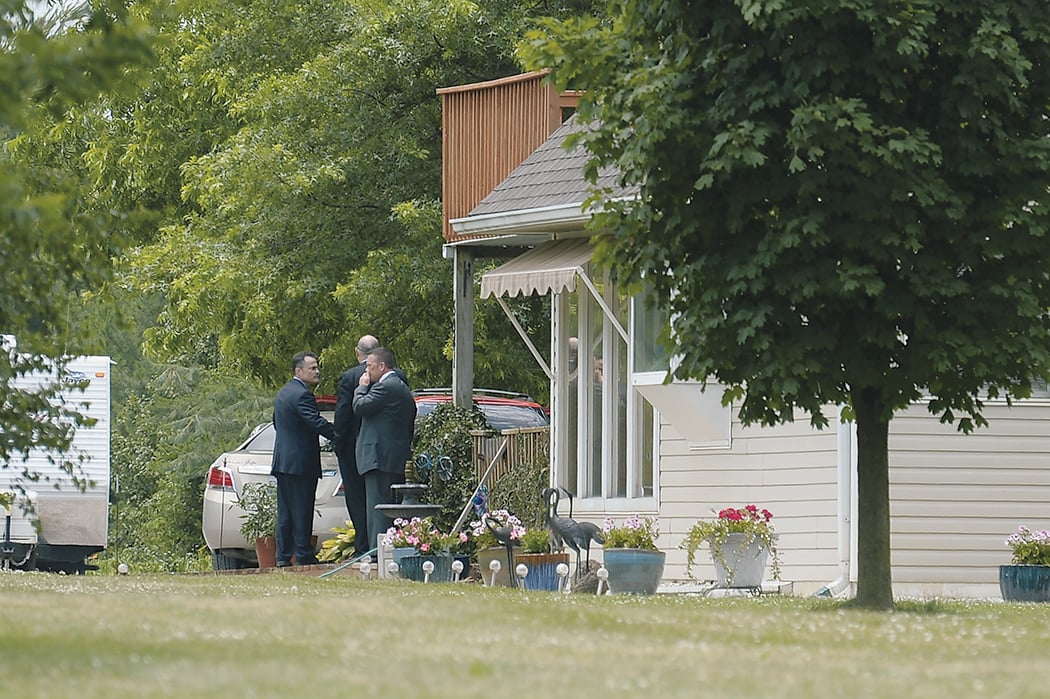
“Excuse me, sir,” Hodgkinson said. “Can you tell me who’s practicing? Are these Republicans or Democrats?”
“This is the Republican team,” Duncan replied.
“Okay, thanks,” Hodgkinson said.
Duncan gave the encounter little thought as he knocked the dirt off his cleats and drove away. Later, he was alarmed to learn he was among the six Republican Congress members whose handwritten names appeared on a notebook page that investigators found on Hodgkinson. Duncan, who has seen the list, says it included his age, Capitol Hill office phone number, and physical description: “It said I was overweight by X number of pounds.”
Hodgkinson returned to his van. He retrieved his assault rifle and two 40-round magazines. He clipped onto his waistband a soft holster with a loaded pistol, and he stuffed an extra six-round magazine into his pocket. He walked up to the chainlink fence running parallel to the third-base line. Witnesses told investigators he seemed calm and that he said nothing. He pointed the rifle toward Kelly. Then he pulled the trigger.
After his opening volley, Hodgkinson began firing more rapidly. Pop! Pop! Pop! Pop! Pop!
The players scrambled to the unlocked gate along the first-base line, the field’s only exit. Some flopped to their bellies by home plate; others leapt into the first-base dugout.
Active shooter! Active shooter!
Tyson Foods lobbyist Matt Mika was only a couple of strides from the exit when he felt a searing heat in his chest. “Like a soldering iron,” he says. He noticed the blood on his shirt, staggered to a knee, but got back up and continued through the gate. On the track inside the fence in the right-field corner, Zach Barth and another assistant coach lay flat on the ground, trying to make themselves small. “I saw him turn and swing his rifle over to us,” Barth says. He listened to bullets scatter the pebbles around him, until a hot pain seized his left calf. Frantic, the other assistant coach jumped up and scaled the 20-foot-high fence along the foul line. Barth dashed toward home plate and dove into a dugout, where a group of lawmakers and aides were ducking the bullets that whistled overhead.
By now, Scalise was the only person left on the diamond. Texas congressman Mike Conaway, who’d found protection behind a dugout, worried that if Scalise moved, he might attract more gunfire. “Lay still!” he yelled to his friend. “Lay still!”
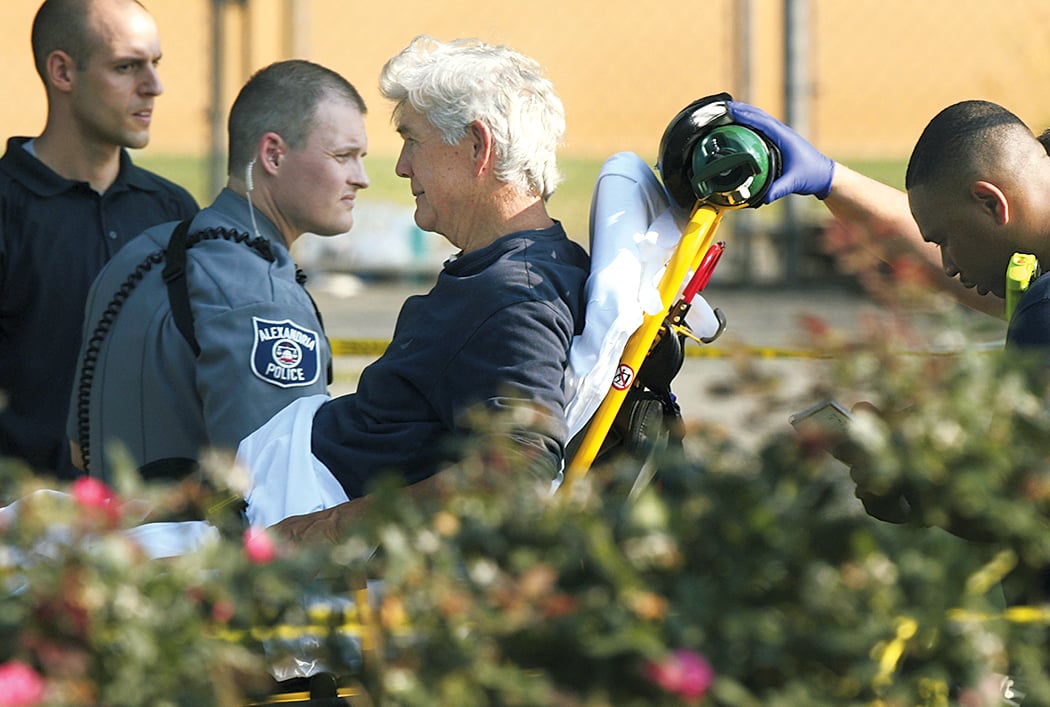
From their unmarked SUV parked 20 feet from the first-base gate, the two Capitol Police officers on Scalise’s protective detail had heard the first shot. They quickly realized that the team was under attack. Special agents Crystal Griner and David Bailey radioed headquarters and activated a distress beacon identifying their location. Bailey moved toward the blasts. While looking around the field for the shooter, he saw players racing off the diamond and pointing to the third-base line. He ran onto the field to try to assist Scalise—the man he was sworn to protect—but the bullets zipping past his head prevented him from reaching the congressman.
Instead, Bailey braced himself alongside the first-base dugout, steadied his Glock, and belted ten shots across the infield at Hodgkinson, who was at the far end of the third-base dugout. At that point, the House whip was still in the gunman’s line of fire, but according to the Commonwealth’s Attorney’s report, Bailey’s shots forced Hodgkinson to move.
The chainlink fence prevented Hodgkinson from entering the stadium, so he walked along the outside perimeter toward the first-base side of the ballpark, where the agents, lawmakers, and staff were clustered. “He’s walking, gun down, Sunday-afternoon hunting,” one witness recalls. “You watch Discovery Channel? You see those guys out patrolling? He was out patrolling. He was a cool customer.”
From behind a shed, lobbyist Brian Kelly kept his eyes trained on Hodgkinson and hollered intel to the Capitol Police officers, who didn’t always have a clear view of the approaching gunman. Singinergle shooter! Male! Beard! At your 11 o’clock!
Hodgkinson passed the bleachers and the press box before reaching the pavement behind home plate. There, he pointed his rifle at the Capitol Police SUV 100 feet away. With their weapons drawn, the agents took cover on the opposite side of the vehicle as Mika lay bleeding on the ground beside them. Farther back, terrified players and coaches hid behind a shed and a large tree. Hodgkinson’s rifle was much more powerful than the agents’ pistols, and now he was heading right for them.
“At that point, I had made my peace,” says congressional aide Nick Uehlecke. “The bullets were getting closer.”
Outside the fence in deep right field, meanwhile, Kentucky senator Rand Paul and Toyota lobbyist Mark Johnson lay flat on their stomachs, paralyzed by indecision. Paul had been waiting for his turn in the batting cage and Johnson had been operating the pitching machine when the shooting began. Johnson wasn’t wearing his glasses and couldn’t see much without them. The echo of gunfire off the apartment building across the street made it sound as if shots were coming from two directions. He recalled the initial confusion he’d felt while watching the news 16 years earlier, as the second plane hit the World Trade Center. This time, Johnson wouldn’t be so naive. This is a terrorist attack, he thought. This is ISIS.
Johnson worried that Hodgkinson was simply trying to flush the players toward a second gunman, or perhaps others, who could pick them off more easily. Moving felt like the wrong thing to do. But as Hodgkinson appeared behind home plate and began firing up the first-base line, the risk of staying put seemed greater. According to Johnson, Paul suggested they run for it, because they had no ability to fight back.
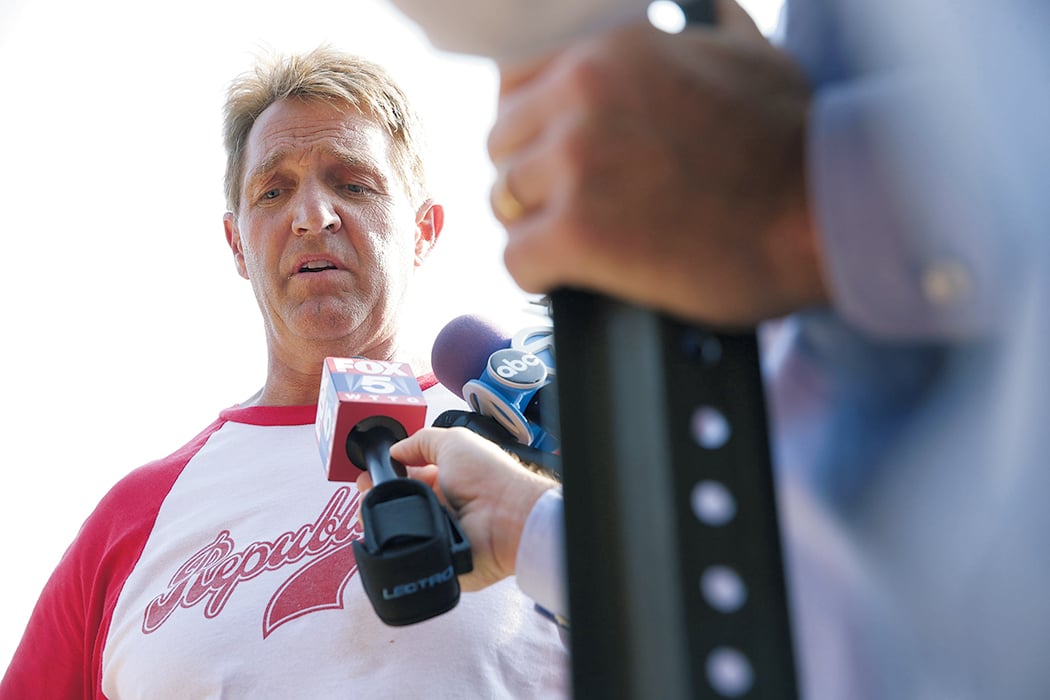
Johnson sprinted from the field, hopped a five-foot-high fence, dashed across a dog park, and kept going. As he neared an apartment building, a Toyota pickup pulled up beside him. Inside were Paul, a former congressional staffer who’d been with them on the field, and the political consultant who played catcher in practice.
One of the men shouted, “Mark, get in!”
Johnson hopped into the bed of the pickup, and they took off. The driver, it turned out, was a congressional staffer—unaffiliated with the team—who’d happened by the field as the shooting started and saw the men in danger. As they headed to Capitol Hill to drop off Senator Paul, they tuned the radio to WTOP to see if there was any news on the shooting. But events were still unfolding.
At the pavement near home plate, Hodgkinson blasted at the Capitol Police officers, and they fired back. The barrage splattered bark on a large tree and popped the walls of a nearby shed, which Georgia congressman Barry Loudermilk and a few other team members were using as protection. This guy is serious about killing us, Loudermilk thought.
Near the back of the first-base dugout, a congressional aide was hiding in his parked car, counting bullets. He figured the cops had to be low on ammunition—what happens when they run out? He imagined a worst-case scenario in which, with no other options, he’d have to start the car and drive at the gunman.
But he soon realized driving was impossible. Texas congressman Joe Barton’s 11-year-old son, Jack—who’d been tossing baseballs with the team earlier that morning—had slid underneath his car for protection. During each lull in the shootout, Jack poked his head up to see what was going on.
“Jack! Get down!” his father yelled from behind the dugout.
Hodgkinson concealed himself behind a storage building and continued firing. A bullet ricocheted underneath the Capitol Police SUV and blazed into Matt Mika’s left arm—his second wound. The 39-year-old lobbyist had played baseball at a small Midwestern college, and he’d joined the Republicans’ team more than a decade earlier while working in the office of Michigan congressman Tim Walberg. Now he lay motionless on his back, face ashen, blood leaking from the massive hole in his chest. As others retreated for better cover, Loudermilk remained ten feet from Mika, behind the SUV, and shouted encouragement. Hey, Mika! It’s gonna be all right!
“I knew Matt wasn’t going to make it,” Loudermilk says. “But I wanted Matt to know somebody was with him when he went into eternity.”
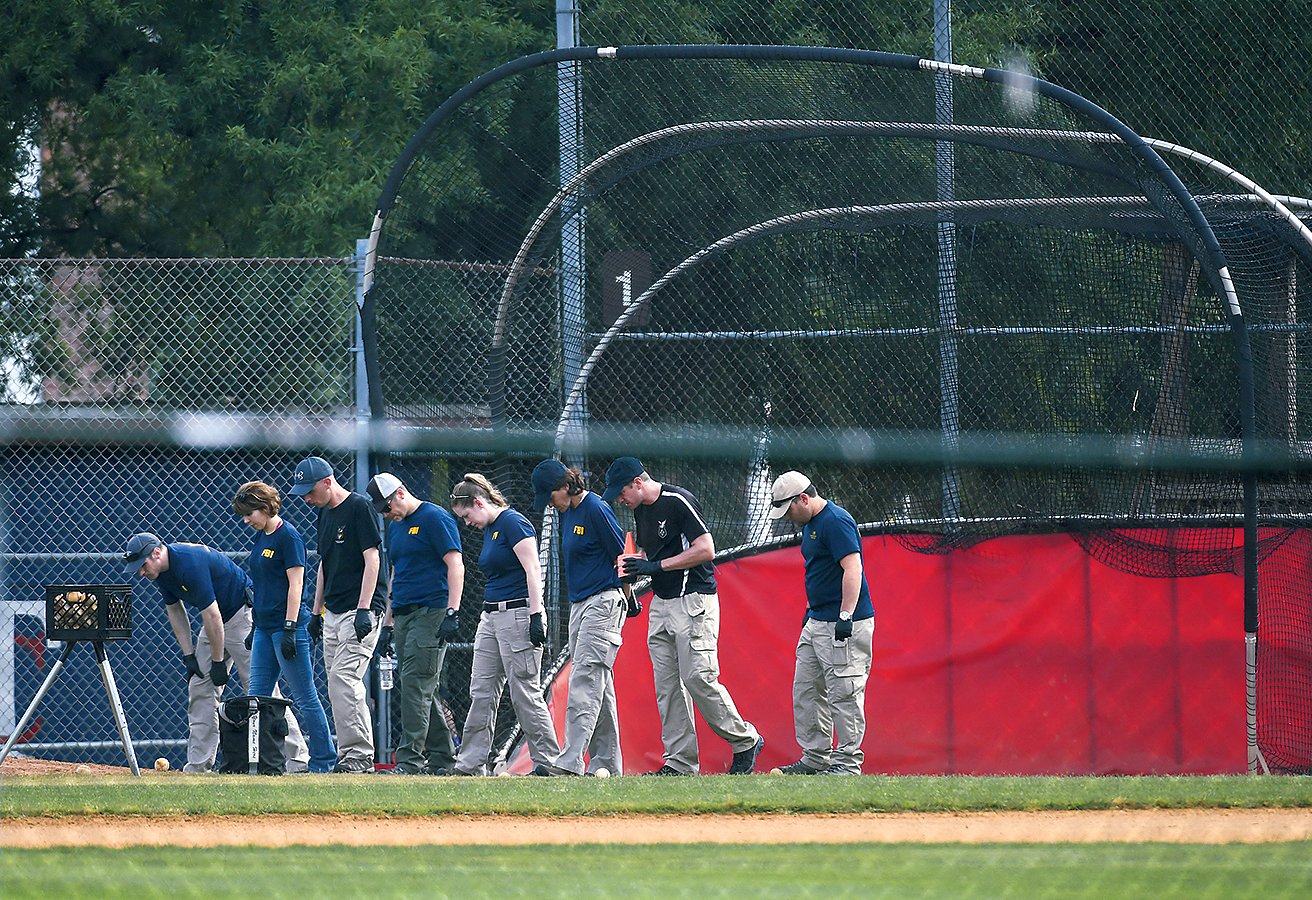
As the shootout continued, Griner extended her leg outside the vehicle’s cover and took a bullet. “I saw her ankle explode,” Loudermilk says. Griner dropped to the ground, but according to lobbyist Brian Kelly—who had also taken cover behind the SUV—she pushed herself back up with the barrel of her pistol and returned fire once more. Later, when she could no longer stand, she shot at Hodgkinson from underneath the SUV.
With Griner down, Bailey was now the only able-bodied officer between the gunman and the unarmed players.
“If he goes down,” Loudermilk said to himself, “that guy’s coming to us.”
Bailey darted back and forth from behind the SUV to a position alongside the vehicle as he fired on Hodgkinson. This gave him a better sightline on the shooter, but it also left him exposed, and eventually he caught shrapnel in his ankle.
Now both officers were injured, while Hodgkinson, unscathed, was still firing. Loudermilk didn’t want to leave Mika’s side but decided it was too dangerous to stay. He darted for a tree farther up the first-base line, his batting helmet still on his head.
Alexander Jensen was in his police cruiser, monitoring the morning traffic from the parking lot of the Cora Kelly elementary school, when reports of “shots fired” crackled over his radio. According to the Commonwealth’s Attorney’s report, the second-year Alexandria cop, in the final hour of an overnight shift, flipped on his sirens and raced toward the ballpark, less than two miles from his position. On the way, he spotted an Alexandria police car driven by officer Nicole Battaglia, and he followed her to the scene.
Jensen could hear gunfire as he approached the stadium. When he reached the entrance of the YMCA parking lot, he stepped out of the vehicle and began looking for the shooter. “He’s motioning, ‘Where is [the gunman]?’ ” recalls New Mexico representative Steve Pearce, who was hiding behind a nearby car. Pearce pointed to the storage building that Hodgkinson was using as protection. When Jensen spotted the shooter, he nodded affirmatively at the congressman.
Battaglia, meanwhile, was approaching the scene from a parking lot on the first-base side of the diamond. Jensen heard Hodgkinson fire at Battaglia and immediately reached into his vehicle to grab his Bushmaster rifle. The weapon was loaded with .223 caliber rounds, 28 in all.
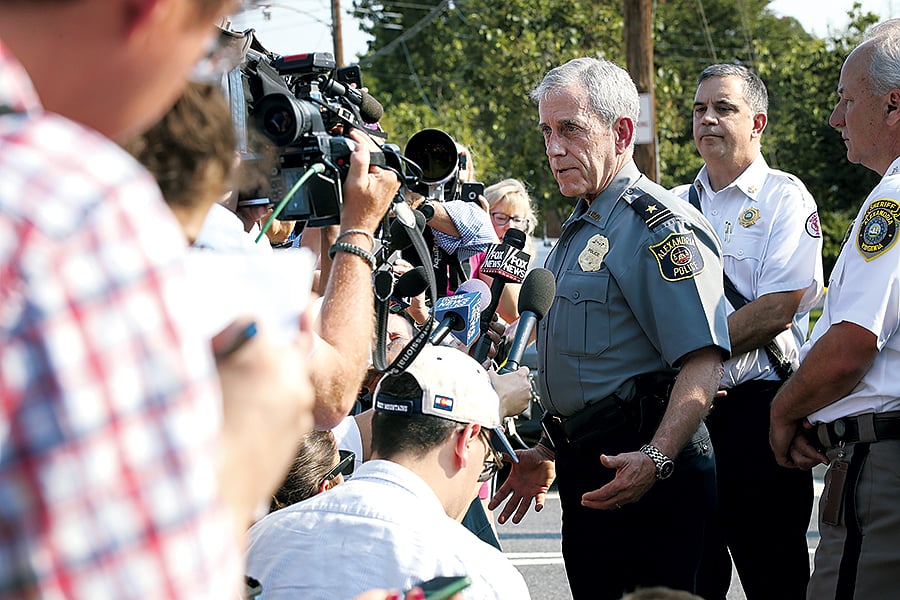
Because Jensen had arrived at the scene from Hodgkinson’s rear, he had a line on his target: Hodgkinson was 200 feet away but exposed. This was the clearest opportunity yet to take him down.
But when Jensen squeezed the trigger, nothing happened—the rifle wouldn’t fire.
By now it was 7:13 am, seven minutes into the gunfight. The people left in the ballpark grew desperate. Alone on the grass behind second base, Scalise listened to bullets pop and continued to pray. Jack Barton had made his way into the dugout, and congressional aide Nick Uehlecke had tucked the 11-year-old under a bench and behind his own body in case, God forbid, the gunman entered. Shots reverberated off the dugout’s concrete walls, and blood from Barth’s bullet wound dripped onto the floor. “It seemed like forever,” says Senator Jeff Flake. “We’re thinking, How long can this go on?”
Officer Jensen checked his Bushmaster and realized it was still in safety mode. He loaded a round in the chamber, took aim at Hodgkinson, and fired. The shot missed the gunman. Jensen fired again. This time, he hit Hodgkinson’s right hip. Hodgkinson buckled and dropped his rifle.
But he wouldn’t stand down. He got back up, pulled his 9mm pistol from his holster, and fired again at Bailey as well as a third Alexandria police officer on the scene, Kevin Jobe, who had taken a position behind Bailey. Next, Hodgkinson shot at Battaglia. Jobe and Bailey realized he was distracted by a new target, so they moved in—advancing directly on Hodgkinson as they fired.
Hodgkinson emerged from the protection of the cement storage building, shooting his pistol, as the officers yelled. Get back! Get down!
Bailey hit Hodgkinson in the left side of his chest, spinning him counterclockwise and giving Jensen a clear shot. Jensen then fired and struck Hodgkinson in the left hip. Hodgkinson dropped his handgun and fell to the pavement. He was trying to get back to his feet, reaching for his gun and moaning in pain, when Jobe handcuffed him. As other officers converged, Jobe radioed that the suspect was in custody. Shooter down! Shooter down! It was 7:15 am.
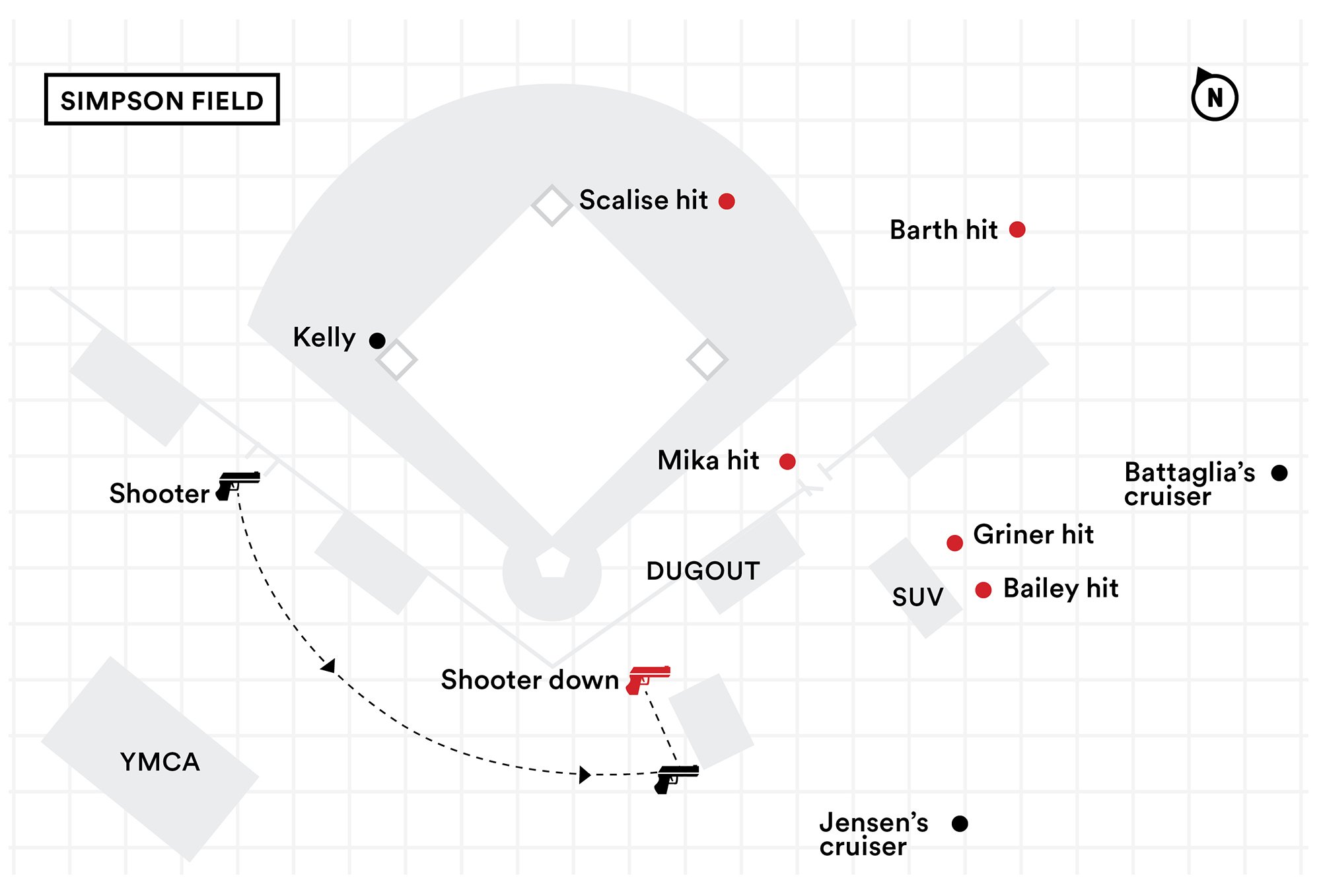
The moment the gunman fell, Congressman Wenstrup took off toward Scalise. Wenstrup had spent the shootout behind a cement bathroom stall outside the fence by right field, anxious to aid his injured colleague. A former Army surgeon, he understood the perils of blood loss and time.
When he reached the grass behind second base, Wenstrup found Scalise lying on his right side, bleeding from a small puncture in his left hip. He tore open Scalise’s baseball uniform and searched for an exit wound. “I don’t see one,” he remembers, “[so] I know he’s in bigger trouble.”
Wenstrup concluded that the bullet had hit Scalise’s hip bone and ricocheted into his midsection, where it could rupture organs and rip open blood vessels. Wenstrup’s mind rewound to 2006, when he was serving in a combat hospital in Iraq and a soldier arrived with injuries from an IED explosion. From the outside, the wounds appeared manageable. But once doctors opened the soldier’s abdomen, Wenstrup saw massive internal bleeding, and when they couldn’t locate the source of the leakage, the soldier died.

Scalise’s condition, Wenstrup recognized, was just as grave. “I don’t think people realized it because, understandably, they just see a little hole.”
After someone retrieved a tourniquet from the SUV, Wenstrup pushed it as far up Scalise’s leg as it would go, hoping to slow the bleeding. Scalise was grunting but conscious. At one point, he looked up at Brian Kelly, who had removed his own shirt and used it to stanch the blood flow before Wenstrup took over.
“Why is your shirt off?” Scalise asked.
“Because I got muscles, Steve,” Kelly replied.
Scalise wanted someone to call his wife, then asleep in Louisiana. The duty fell to Flake, who was also helping triage the congressman. Flake did his best to reassure Jennifer Scalise, but he told her the truth: “There’s been an incident. Your husband has been shot.”
Just then, Alexandria firefighter and paramedic Rick Krimmer arrived with a stretcher, and first responders grabbed Scalise by his uniform and lifted him onto it. As Krimmer rushed the congressman into his ambulance, he was asked if he needed a medevac and responded that he wanted to examine the congressman first. He started an IV, administered medication to help Scalise’s blood clot, and ran his vital signs. Despite Wenstrup’s tourniquet, the congressman was slipping away. “Blood pressure’s down, heart rate’s going up. His level of consciousness is coming and going,” Krimmer recalls. “We needed to get him to a trauma center because there was damage inside that I can’t treat.”
Krimmer stuck his head out of the ambulance: “Go ahead and give me a helicopter.”
“We’re thinking, how long can this go on?”
Typically, it’s faster for Alexandria first responders to transport patients by ambulance rather than helicopter. But in this case, the US Park Police had already dispatched its Eagle Four chopper to the stadium.
Over the thwacking of rotor blades, Krimmer helped load Scalise into the cabin and yelled the key details—Gunshot wound to the hip!—to the Park Police medic onboard. Then the twin-engine took off.
Krimmer retreated to the ambulance to put away his equipment and medication. By now, dozens of law-enforcement officers had arrived to secure the area, as a throng of reporters jostled for details about the shooting. Krimmer felt his phone buzz. It was a text from his wife, who’d seen footage of him on the news.
“Were you the one who treated the congressman?” she asked.
“What congressman?” he replied.
All he’d known was the patient’s first name, Steve.
At 8:10, Eagle Four landed on the helipad at MedStar Washington Hospital Center, the dome of the Capitol poking above the trees in the skyline to the south. Scalise’s stretcher was hustled through the glass doors and into Trauma Bay 2, a cramped room with two spotlights hanging from the ceiling. Members of the congressman’s protective detail gathered nearby as the Park Police medic pulled aside Dr. Christine Trankiem Wall, a MedStar trauma surgeon.
“Do you know who this is?” the medic said.
No, Wall replied.
“It’s the majority whip.”
Scalise’s blood pressure had plummeted to 78, a dangerously low measurement. The congressman had barely enough blood in his vascular system to continue pumping oxygen to his brain. Doctors transfused him with about a half liter of blood, hoping to strengthen the flow. But his pressure didn’t improve. “He’s bleeding out as fast as I can give him blood,” recalls Dr. Anthony Shiflett, the trauma surgeon on duty. “That means he’s going to die within minutes if I don’t do something about it.”
There was leakage somewhere, and Shiflett needed to find it. Using an x-ray device, he determined that the bullet had cut clear across Scalise’s pelvis. “Horrible news,” Shiflett says. The pelvic region is wrapped in a grid of critical blood vessels, and its location, submerged in the lower abdomen, is tricky for surgeons to work in. “We had our backs against the wall,” Shiflett says. “In a big way.”
Doctors rolled Scalise into the operating room. Outside the door, law-enforcement officers in tactical gear cleared the hallway of patients and staff. Shiflett was joined by the dean of MedStar’s surgical team, trauma director Dr. Jack Sava, who made an incision down the congressmen’s belly. But when they opened him up, there was too much blood in his abdomen to tell what was leaking. They would have to use a painstaking process of elimination.
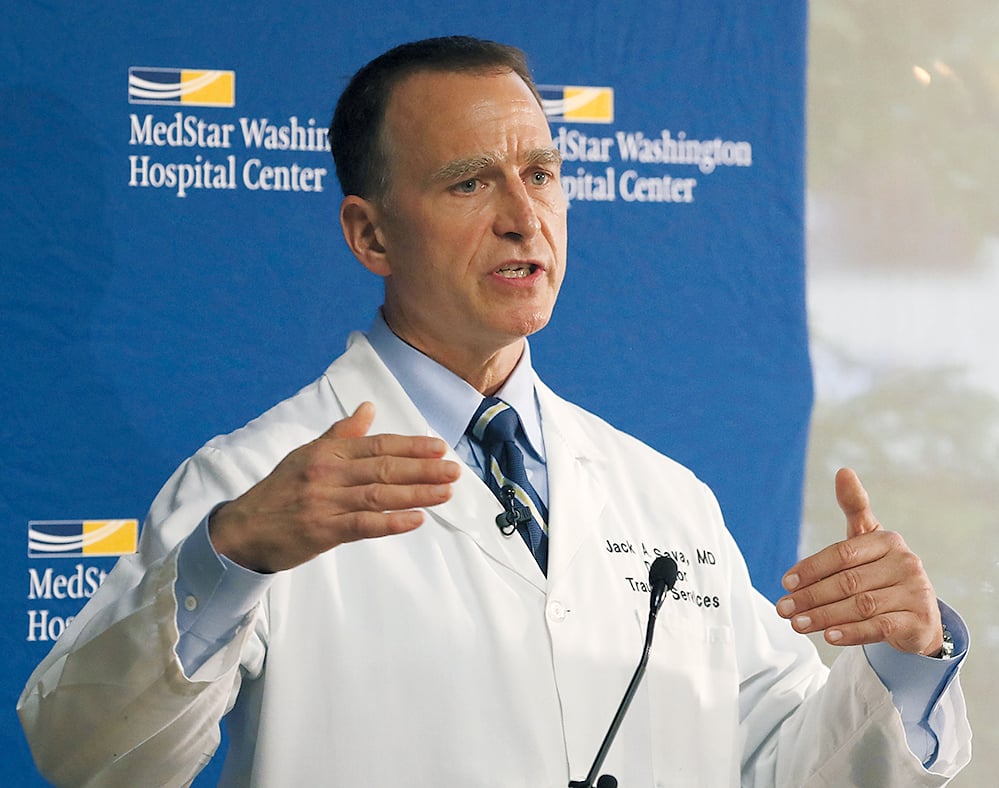
Sava and Shiflett placed a clamp on Scalise’s aorta, the body’s main artery, which cut off blood flow to the damaged vessels and helped stabilize his blood pressure. Looking downstream from the clamp, they searched for pools of blood—which indicate that surrounding vessels are punctured—and plugged the leaks with stitches or additional clamps. They then moved the clamp a short distance down his aorta and repeated the exercise. For roughly two hours, they inched lower and lower into Scalise’s vascular system, patching as quickly as they could, until they made another ominous discovery.
Much of the bleeding, it turned out, was coming from leaking vessels located too deep in Scalise’s pelvic region for them to reach safely. The surgeons had hit a dead end—if they couldn’t access the punctured vessels, they couldn’t stem the blood loss.
Had Scalise been taken to a traditional community hospital, this is the point at which he would have died. But at a Level One trauma center like MedStar, there was still one thing left to try.
Around 10:30 am, the surgeons placed a plastic sheet over the still-open incision in Scalise’s abdomen—their clamps now on two arteries deep in his pelvis—and wheeled their patient past the armed federal agents in the hallway. They were headed to a different room to see Dr. Arshad Khan. Instead of traditional surgery, Khan would use an advanced practice known as interventional radiology to try to save the congressman.
Khan poked a tiny hole in Scalise’s groin artery and threaded a thin catheter through the femoral artery, an access point to his vascular system. Sava then removed one of the clamps, allowing Khan to inject contrast dye into the region. On the x-ray monitor, he saw the dye form pools around a pair of arteries. It was these two broken arteries he had to plug.
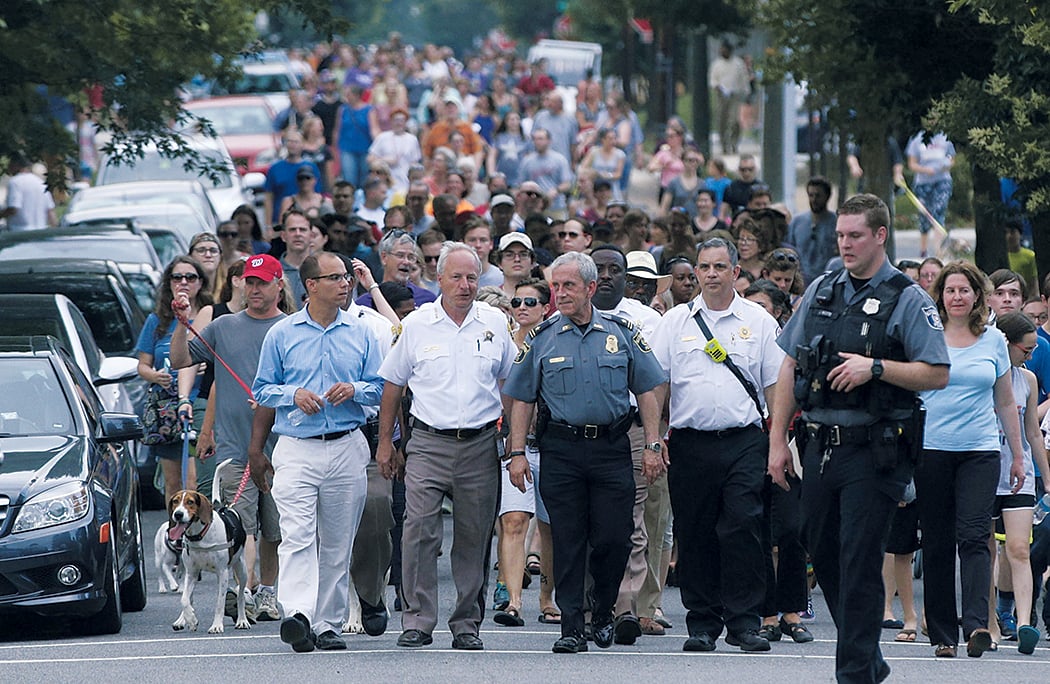
The doctor had just minutes to work. Releasing the clamp—though necessary to identify the source of the leakage—had restored blood flow to Scalise’s porous pelvic region, draining his vessels and crashing his blood pressure. Federal agents were posted outside the door, and the room had filled with nearly a dozen doctors and staff. Khan could feel the eyes on him as he eased an even smaller catheter into the damaged arteries and used tiny metal coils to try to plug the leaks.
“Did you get it? Did you get it?” his colleagues asked.
Within 16 minutes, Khan believed he had the coils in place. Just then, the anesthesiologist noticed Scalise’s blood pressure improving. He turned to Khan: “You got it.”
Scalise, at last, was stabilizing.
After the procedure, Shiflett remained troubled by the disturbing news about how Scalise had wound up in his operating room. The surgeon called his wife with a warning: “Don’t answer the front door, and don’t answer the phone if you don’t recognize the number.” Shiflett worried that someone might retaliate against him if it was discovered he’d operated on the majority whip. In the coming days, he did all he could to keep his role in the surgery secret. He refused to stand for press pictures, and he skipped the White House event honoring the cops and first responders.
“If a celebrity gets shot, the nation mourns,” says Shiflett, who had spent the early part of his career in Los Angeles. “[But] people are so emotional over what’s going on in Washington, DC, that you never know how people are going to react.”
After the police had finished their interviews at Simpson Stadium, the congressmen and their aides piled into a police bus and headed back to Capitol Hill. At one point, they got stuck in late-morning traffic, and Representative Davis called the staff director for the House Committee on Administration, who arranged for their police escort to turn on their sirens and clear the lane. Loudermilk got off the bus at the Capitol steps, crossed Independence Avenue, and approached the entrance to the Cannon Building, where his office was located. He had been unable to retrieve his wallet from the dugout, which was now an active crime scene, so he had no identification. Security officials initially refused to let Loudermilk in.
Flake walked into the congressional gym in his cleats and baseball pants, smudged with blood. He turned to a gym attendant who handled the laundry. “Can you get these stains out?” Flake asked. Both men broke down crying.
Kelly resolved not to let Hodgkinson disrupt his work schedule. So at 12:30 pm—5½ hours after he had locked eyes with his would-be murderer—Kelly sat at a podium in the Rayburn Building for a small-business committee hearing. “We the people of this great nation,” he told the room, “will not be intimidated by cowards.”

In that same spirit, Republicans decided to play the Congressional Baseball Game, as planned, the following day. Jack Barton was one of the batboys. And although the GOP lost 11–2, the event raised more than $1 million for charity, double the previous year’s haul. Afterward, Pennsylvania congressman Mike Doyle, who manages the Democrats’ team, handed the trophy to the Republicans for display in Scalise’s office.
Over the next two weeks, Scalise underwent multiple surgeries. Doctors finished patching his vessels, repaired the broken bones in his hip, and tackled the assorted infections and complications that flared up along the way. During the first frantic hours at MedStar, Scalise had been infused with about six liters of blood—the body holds about five—and this extreme cycle of blood loss and replenishment had jolted his system. When he was healthy enough for visitors, agents Griner and Bailey came by his room, and the congressman was able to say thank you. “They saved my life,” Scalise says. “Plain and simple.”
Griner is still getting back to full health. Bailey has fully recovered. In the weeks after the incident, he told Representative Roger Williams just how close to death they’d all come. Bailey showed the congressman a photograph of the front of his cell phone, which had been shattered by a bullet or shrapnel during the gunfight. “If it hadn’t hit his cell phone, it might have done some real damage to him,” Williams says. “And if he’d been taken down and wouldn’t have been able to defend [us], none of us would have had a chance.”
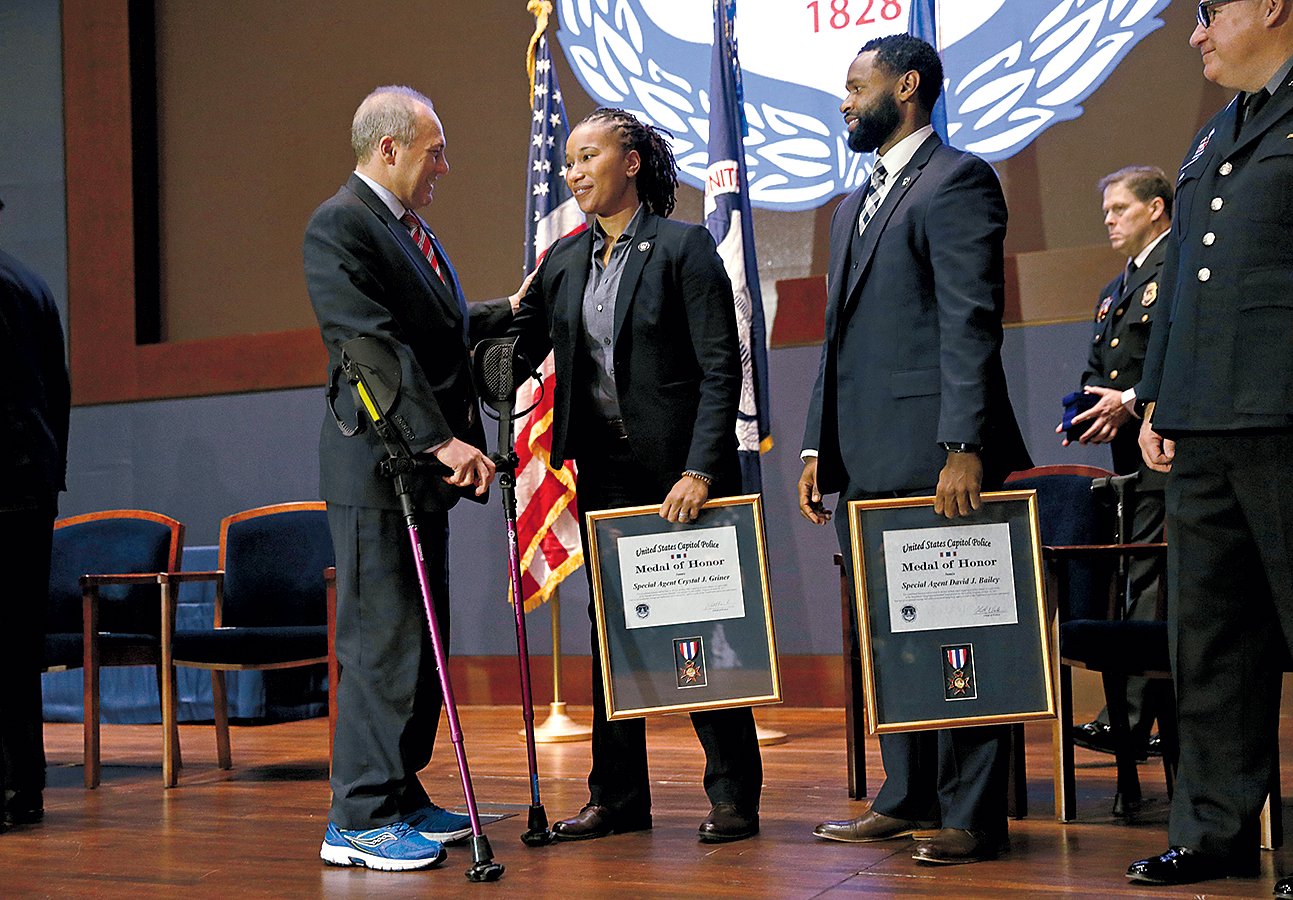
In July, President Trump awarded the Medal of Valor to the Capitol Police and Alexandria Police officers. At this and other ceremonies, Matt Mika reunited with the paramedics and trauma surgeons who had saved him. Before long, he says, they became “like a little family.” Hodgkinson’s bullets had barely missed Mika’s heart and collapsed his lung. Zach Barth, the aide who was shot in the calf, also made a complete recovery.
Later that summer, some of the coaches and their family members returned to Simpson Stadium for the first time. Each coach had experienced the shooting from a different vantage point, and Mark Johnson, the Toyota lobbyist, found it cathartic to hear their stories and share his. They put their fingers into the bullet holes in the dugout and along the shed, and afterward one of the assistant coaches said, “We’re going to make this field what it’s supposed to be.” He and his brother jogged into center field, put on their baseball mitts, and began playing catch.
The Congress members who lived through the shooting were affected in lasting ways. Loudermilk had recurring flashbacks of running off the field and watching Mika bleeding on the pavement. Williams sometimes startles when committee chairs bang their gavels. What wasn’t affected was their positions on gun control. Some regretted not having their own weapons while Hodgkinson fired at them. Representative Mo Brooks subsequently introduced a bill that would have allowed lawmakers to carry concealed firearms. (It didn’t pass.)
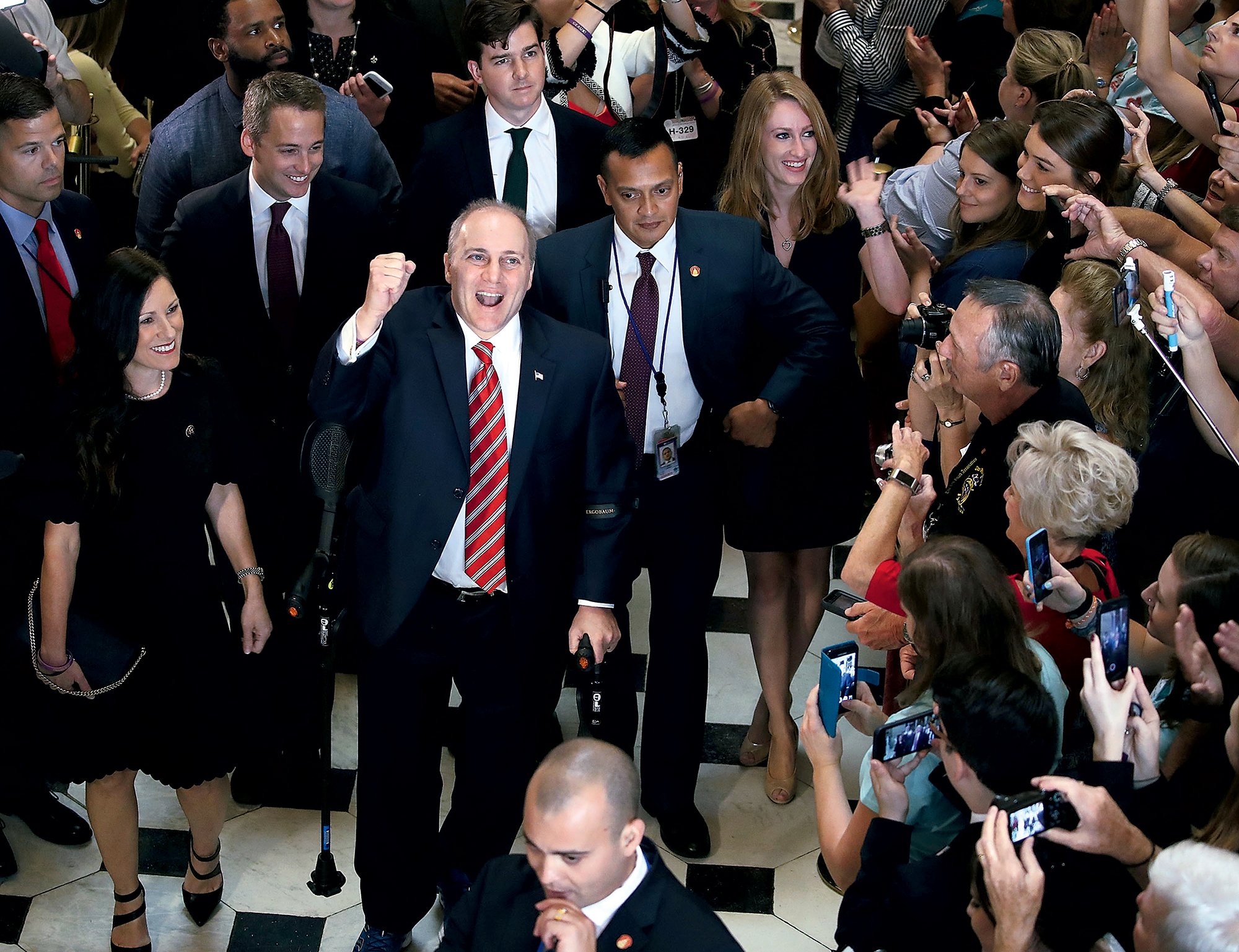
Hodgkinson died from gunshot wounds at George Washington University Hospital. His wife, Sue, later told reporters she’d had no idea he would take such action. Her neighbors have warned her not to mow her lawn, out of concern that she could be attacked, according to the New York Times. Once while she was in a grocery-store parking lot, according to the Times, a female stranger walked up and slapped her across the face.
Today Scalise works the halls of Congress using hand crutches. He does physical therapy three days a week and is optimistic he’ll be walking unassisted soon. His career may be advancing as well. With speaker of the House Paul Ryan retiring from Congress at the end of this term, Scalise is a candidate for the GOP’s top leadership post. But regardless of his place in the pecking order, he’ll always have the gratitude of the lawmakers and aides on the baseball field that morning. Had Scalise missed the practice, there would have been no Capitol Police officers at Simpson Stadium. No protection from the gunman.
Says Wenstrup: “He took a bullet for all of us.”
This article appeared in the June 2018 issue of Washingtonian.
Correction: An earlier version of this article incorrectly credited two photographs.
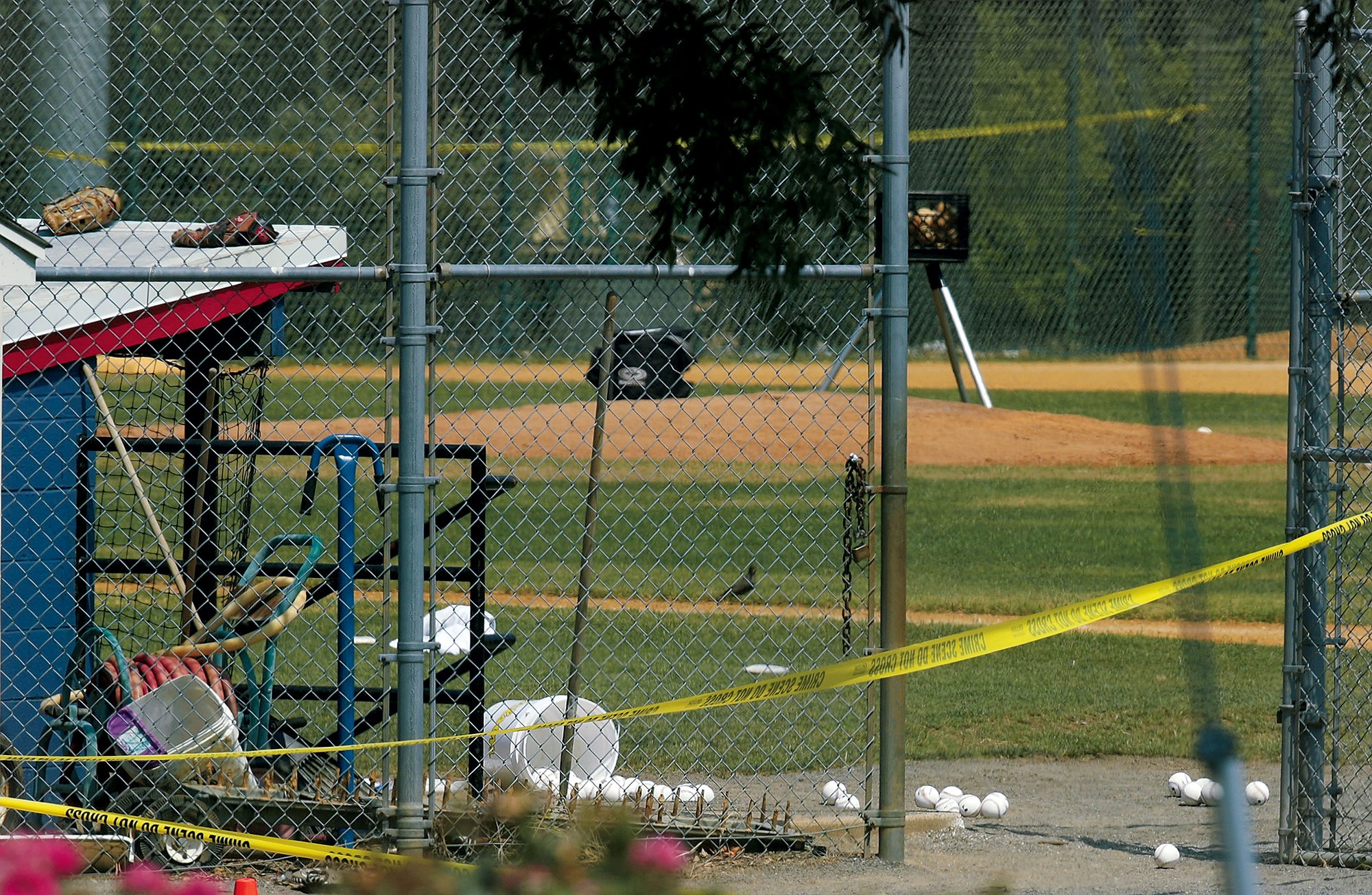
![Luke 008[2]-1 - Washingtonian](https://www.washingtonian.com/wp-content/uploads/2017/10/Luke-0082-1-e1509126354184.jpg)







